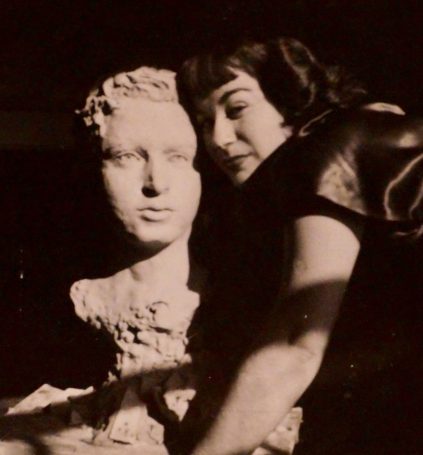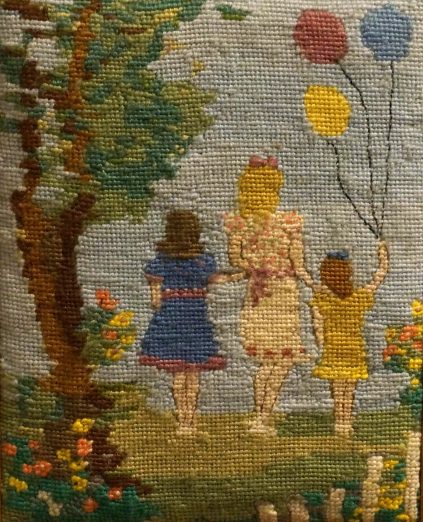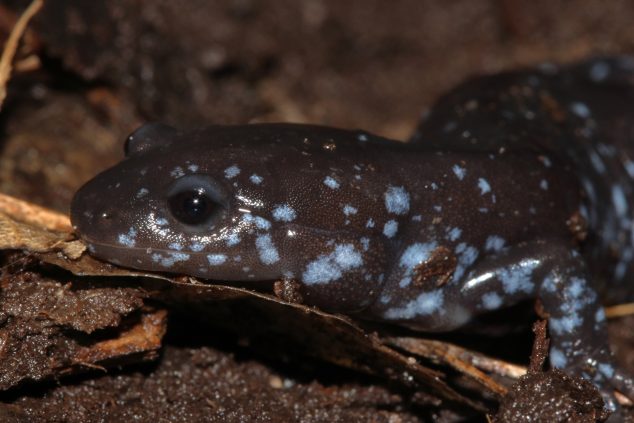Edna and Al
By Harrison Goldspiel
How Can a Head
It began with a man and a woman, as many stories do.
They met on the beach in the Rockaways at the southern edge of Queens. It was the crux of the 20th century, an indelible ecotone of time. Families sprawled across the sandy peninsula like so many ants, enjoying an innocent pause between one war and another.
Albert was a fortunate man. After a short period of training in the Colorado mountains, he found himself miraculously spared from war, returning home to New York instead of Korea. Returning to a large family and the certain pleasures provided by the coastal city.
It’s hard to say what he first noticed about her. Edna was a peculiar woman of many signals. She rode bikes and roller skated. She climbed billboards and trees. She smoked cigarettes. Of all her curious signals, smoking was the only one he cared to extinguish.
Edna was an artist. Shortly after their first oceanside encounter, she invited him to her family’s home in Brooklyn to make his head. He didn’t quite understand what she meant then, luring him to a quiet room with a solemn chair and instructing him to sit down. After retreating to another room, she returned to him with a giant block of clay. She made his head.
Sculpture was Edna’s specialty. She had a natural gift for capturing fine features of life on clay, producing a wide range of impressions of the natural world around her—innumerable flowers and faces, large and small, bound by silica and sweat. She saw something special in Al. After an isolated session in her family’s home, she created an earthen model of his youthful face, detailing his essential attributes and preserving the replica with plaster of Paris.
Edna shared her gift with Al, teaching him the art of impression. She was one of his subjects, staying still many years later while he carved her likeness into smooth clay. Their heads sat next to each other, resting beside an assortment of faces on their bedside, from their marriage into the next millennium.
One Spot, Two Spot, Yellow Spot, Blue Spot
It began with a male and a female, of that much we are fairly certain.
They met somewhere in eastern North America, several millions of years ago, at the interface of two geological epochs. Who exactly met whom? Well, that’s up for debate.
They were salamanders, of course.
They met as many salamanders do, in a wetland on a warm spring night. There they resided, for a short period, before spawning their own remarkable creations and returning to the land. In time, their offspring followed suit, transforming and emerging from the water. And so it went, as it had gone since time immemorial, from water to land and back again. An endless cycle between two worlds.
The salamanders lived in this fashion, moving dynamically through the world, persisting through manifold change from Miocene to Pliocene to Quaternary, riding the slow tide of glacial maxima until they found themselves sprawled across a wide expanse of land from the Great Lakes to the Atlantic Ocean.
Of the various amphibians found in Maine, blue-spotted salamanders are perhaps the most mysterious. While frogs sing their way through spring, proudly announcing themselves to the world and every potential mate, predator, and occasional human spectator, salamanders remain silent, emerging from a subterranean maze to move quietly across the woods, slipping into their mating habitat with hardly a splash.
Most people know salamanders from fortunate (or unfortunate) encounters on land, where they can be found roaming the forest floor after a rain or migrating over roads on a warm, wet night. These moments during their surface movements and brief residency in certain wetlands offer a tiny glimpse into their populations and ecology. Outside of these windows, salamanders are cryptic creatures, mostly residing underground, hidden from our view.
Maine has eight native salamander species (or maybe nine, but we’ll get to that later). While some people are familiar with large spotted salamanders (Ambystoma maculatum) and their bright yellow dots or widely abundant red-backed salamanders (Plethodon cinereus) and their typical red-orange dorsal stripe, relatively few know of the blue-spotted salamander. Blue-spotted salamanders, so named for their rich blue flecks against a jet-black body, are comparatively rare and hard to find.
Biologists and wetland ecologists tend to study amphibians by observing their mating activity and counting their egg masses. These egg mass counts comprise the regulatory backbone for protecting many amphibians and their aquatic habitats—organisms and ecosystems that remain among the most threatened worldwide.
Blue-spotted salamander eggs are not like the rest. While spotted salamander eggs form large, compact egg masses that are fairly visible and countable from a wetland’s edge, blue-spotted salamander eggs barely come together, appearing as single eggs or small and loose clusters that often break apart, dropping to the lower depths invisible to the biologist’s focused eye.
Amphibians are rapidly declining around the world and habitat loss remains one of the greatest threats to amphibian biodiversity. Understanding where and why species are where they are is an important prerequisite for amphibian conservation, but many species, such as blue-spotted salamanders, linger in mystery because of their elusive nature. Many populations remain undocumented and are likely experiencing losses unknown to us—silent extirpations against the backdrop of environmental change. We can hear (and see) the trees falling in the forest. No one hears the salamander. No one knows their sound.
In the last twenty years, wildlife biologists took inspiration from the molecular world and devised a new technique to better illuminate cryptic species. Rather than searching endlessly for loose, drippy eggs and the critters that made them, they began looking in the environment for something much smaller and far more abundant: DNA.
Environmental DNA (eDNA) is all around us. It is in the air we breathe and the tap water we drink. It is in our lakes, ponds, streams, and soil. Wherever creatures live, eDNA usually follows, like fingerprints at a crime scene, quietly lingering after the culprit disappears. Species are defined, in large part, by the unique genetic code contained in their cells as double helix structures comprising megabytes to gigabytes of information—each genome its own molecular magnum opus. A signature sculpture in miniature. When those cells leave the body, as many frequently do, the genetic material leaves as well, finely packaged in discarded hair, mucus, and other biological byproducts that spread throughout the local environment. One salamander’s waste is another man’s treasure.
The first animal studied with eDNA was a frog: An American bullfrog (Lithobates catesbeianus) living abroad in France [1]. Researchers collected water from ponds and used a lab technique—polymerase chain reaction (PCR)—to amplify frog DNA from the water, confirming their presence in the environment. This technique has since been adopted for many more life forms in many more ecosystems, from alpine zones to the deep sea.
In Maine, eDNA has been used to study turtles, mammals, and anadromous fish, providing scientists and environmental managers a broader net for detecting rare species of conservation and management concern. Perhaps our salamanders will be next. Perhaps we can use eDNA to find our mysterious A. laterale—our amphibious Al.
Like a human head sporting various ubiquitous features (eyes, ears, nose, mouth, and so on), DNA has many regions that can appear quite similar between different species. The art of head sculpture is identifying the small idiosyncrasies that define an individual’s face—the width of the eyes, the length of the nose—and fashioning those essential traits as accurately as possible. The trick to eDNA is finding a unique genetic sequence, one that distinguishes one species from all the others that may be found in the same place, and homing in on that sequence with molecular keys—primers and probes. This is no trivial task. Life on Earth has been evolving for billions of years, churning out countless genomes and creatures. The ones we’re aware of (and have sequenced) are mere fragments of the total. Of those we’ve documented, some creatures are quite distinct and easy to parse from others. Our blue-spotted salamanders are something else entirely.
Offspring
Edna and Al had three children, all daughters.
The house was bursting with activity and childhood trinkets. Al found himself surrounded by females. Outnumbered. Everywhere he went, they followed. And following them all was Edna, steadfast and eccentric as always, teaching them all the ways of art, incorporating images of the girls into new pieces that increasingly adorned the walls of their home. Gone were the days of isolated intimacy and quiet impressionism. There were new muses. New faces to capture in oil and fiber and clay.
When their eldest was five years old, she took her turn on the sculpting chair, sitting patiently as Al created a nearly perfect rendition of her tiny head under Edna’s tutelage.
When they were old enough, they dispersed into the world in pursuit of new paths. One became a radio disc jockey, and then a scientist, and then an editor. One became a medical doctor. The youngest became a singer, performing for many years before joining the corporate world.
Through all their travels, they remained in a close orbit around Edna and Al. Or rather, they revolved around each other. The oldest two daughters ultimately returned to the childhood neighborhood to stay and raise their own offspring. The youngest and her family lived afar, frequently returning for visits until Edna passed away and Al eventually found his way to her, spending his last years by her side.
Sex Education
It’s time to back up again.
A few million years ago, a funny thing happened on the way to the forest. Something that’s never happened before. At least we don’t think it has. Not quite like this.
Most amphibians have two sexes, female and male, which reproduce with each other, creating more females and males, and so on and so forth, ad infinitum. Egg and sperm. X/X and X/Y (or Z/W and Z/Z, for many amphibians, but that’s another matter).
In Maine, blue-spotted salamanders are typically found with other, nearly identical looking salamanders that are nearly always female. They are the unisexual Ambystoma.
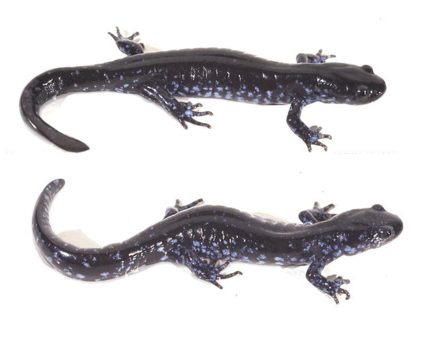
Unisexuals reproduce in a rather clever way, “stealing” sperm from male, blue-spotted salamanders to fertilize their eggs without necessarily using the sperm’s genetic material. The eggs develop into larvae, all females and often clones. This is where it gets tricky. Sometimes, a unisexual will incorporate DNA from the sperm into her offspring by genome addition or replacement. While most animals are diploid, containing exactly two copies of their genome, unisexual Ambystoma are polyploid, often containing three. Or four. Or in very rare cases, five. Kleptogenesis, they call it. A unique reproductive mode all to themselves [3].
How and why they do this is fuzzy, but there are some ideas. An all-female population can grow faster than one with both sexes—a competitive advantage in a resource-limited world. Sex promotes genetic diversity, preventing harmful mutations from accumulating in a population. Unisexual salamanders are reproductive double-dippers. They have their cake and eat it too.
The benefits of being unisexual and polyploid are not without their limitations. Unisexual Ambystoma have elevated rates of early egg mortality [4]; it’s not uncommon to see opaque, molding eggs in their egg masses. Unisexuals move less than their sexual counterparts; they tire more easily [5], as if all those extra genomes are dragging them down. Nevertheless, they persist, having existed in this arrangement for millions of years, defying all our usual conventions about life and sex. And species! Unlike the blue-spotted salamander, which was formally named Ambystoma laterale in the mid-1800s, unisexuals has gone by various Latin monikers in the last century that have resisted widespread, long-term adoption of a scientific name and species designation. Unisexual Ambystoma is the best term we’ve currently got.
In Maine (as elsewhere), our knowledge of blue-spotted salamanders depends on our knowledge of unisexuals. And vice versa. The two are deeply linked, genetically and ecologically. For nearly a century since the unisexual Ambystoma were first described, many have pondered how these two creatures co-exist. One depends on the other, limited by a finite supply of sexual and ecological resources.
The first scientist to report on these salamanders in the early 20th century, Clanton, remarked on the eventual consequences of such a bizarre interaction, theorizing that sperm-dependence of unisexuals would lead to population collapse in the sexual species [6]. Some researchers have identified locations where this may be happening in wetlands devoid of any diploids and suitable sperm, populations shrinking over time [7]. In so many populations, unisexuals seem to dominate the diploids, persisting with a heavily skewed ratio, boggling many bright ecological minds. In Maine, this is usually the case in our vernal pools. To date, we still aren’t sure of any places where our blue-spotted salamanders exist without unisexuals.
As with our sneaky, blue-spotted salamanders, unisexual salamanders are cryptic creatures, fossorial and elusive. Together, they present unique challenges for researchers. They are hard to find. And they are hard to tell apart. Unisexuals grow larger than blue-spots. Under a certain size, all bets are off. A tissue sample is often needed—a small clip of the end of the tail (it grows back)—to examine their DNA more carefully.
Here we see the potential benefit of eDNA for these “double cryptic” critters. Trapping is hard work. As a wise student from Chicago once said (paraphrasing), salamanders move pretty fast. If you don’t stop and trap in the right place at the right time, you could miss them [8]. Collecting tissues and analyzing them in the lab adds more complexity, demanding permits and additional levels of expertise and equipment. Collecting a water sample is a lot simpler.
But wait, you say, didn’t you mention clones? Isn’t their DNA the same? How does any of this work? You lost me at kleptogenesis!
I hear you. These are all good points.
To your second question, I say that none of us know how these creatures really work. The biological mechanisms behind this complicated mode of reproduction remain a mystery. But some very talented scientists in Indiana are currently working on figuring that out.
To your first question, I say this: You are right and wrong. These are no normal salamanders. These are Schrödinger’s salamanders. Their DNA is the same. Except where it isn’t.
Relatives
It began with a man and a woman. A different man and woman.
They met in the early 1900s in New York City, during the Great War. Their families had left Europe like so many others at the time, emigrating to America, where they arrived with fresh dreams, accents, and surnames.
Sam was a merchant of fruits and vegetables. He raised poultry. A man of the natural world.
They were introduced by Sam’s sister and soon married, living for a short time in New Jersey before settling in Brooklyn. Gussie was a dynamic woman, bombastic with energy and well-known to her descendants for two key fixations in life: food and sex.
They had five children: Murray, Sylvia, Bill, Beatrice, and little Albie.
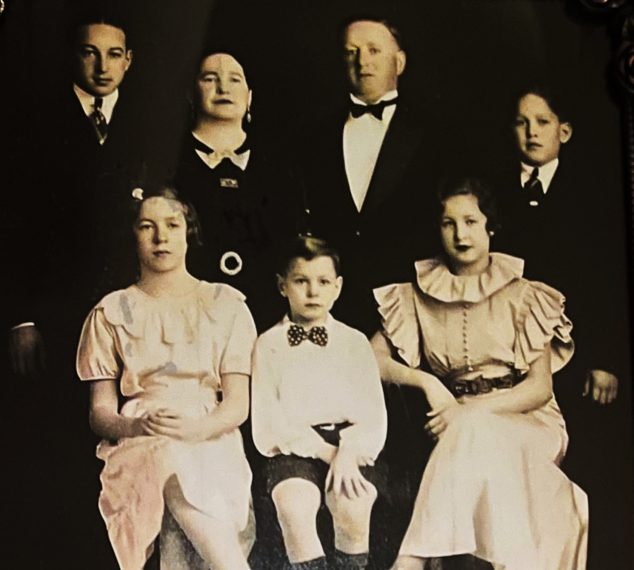
Al was close to his big brothers and sisters. The five siblings were inseparable as children, forging bonds during the Great Depression that resisted the frays of time and distance. They were reared on rich foods and Yiddish humor. They consumed stories from their elders, in time becoming enigmatic storytellers themselves. As adults, they journeyed in new directions, spreading across the continent and starting new lineages under various names, thousands of miles apart. They had new dreams, accents, and surnames. They never forgot their heritage.
Al remained in New York with Edna and their three girls, down the road from his older brother Murray and his family. He became an engraver, managing the family shop with Murray for fifty years and building his own private engraving workshop in his basement, where he spent many hours tinkering with his tools at night in the subterranean space. And he kept making heads, using Edna’s signature technique to capture even more members of the family in clay.
Conservation for a Complex
Here is where the story comes together. Here is where all the little strands align. It took a little while, but life is complex. Sometimes you need to meander. Like a salamander.
So far, we’ve established two things. Blue-spotted salamanders are hard to find. And they aren’t always what they seem. They are shadowed by unisexuals, who use their DNA in strange ways. But they aren’t the only ones being shadowed.
The unisexual Ambystoma are part of a complex of salamanders spread across eastern North America, from Nova Scotia to Minnesota. Like little Albie, the blue-spotted salamander is but one member of this expansive group of species. There are four more, including the Jefferson salamander (A. jeffersonianum), tiger salamander (A. tigrinum), smallmouth salamander (A. texanum), and streamside salamander (A. barbouri). Blue-spots are the smallest of them all.

In Maine, we only have blue-spotted salamanders and their unisexual dependents. No other members of the complex exist here today. But unisexuals are more than meets the eye. In all their cells, they carry multiple genomes from multiple species. Examine the DNA of any unisexual salamander in Maine and you’ll find two distinct nuclear genomes from two distinct species: Blue-spotted salamanders (L) and their larger Jefferson (J) relative. Usually in the triploid variety—buy two blue-spots, get one Jeff free (LLJ).
Somehow, despite being hundreds of miles away from the nearest Jefferson salamander, these unisexual Ambystoma in Maine can’t let go of their past. They are large, they contain multitudes. The story is similar in other places. Wherever you go, unisexuals contain a strange composite of genomes from other species in the complex. In the Midwest, where many of the diploid species co-exist, unisexuals are extra freaky, containing three or even four distinct genomes all at once [9].
Herein lies the problem for these salamanders and eDNA. If you find DNA from the blue-spotted salamander genome in a wetland, how do you know who it’s from? If you are in Ohio, where all five sexual species occur, how do you distinguish a tiger from a tiger, a blue from a blue? A single wetland may contain DNA from two or three or four species, even when only one or two are actually there (this is a separate concern with eDNA, but we won’t get into that here).
This problem is especially relevant for blue-spotted salamanders, whose genome uniquely appears in every known unisexual “biotype” (the many different genome combinations observed in unisexual Ambystoma). The unisexuals have a special connection to the blue-spotted salamander, not unlike Al’s daughters, following him in New York and beyond, proudly carrying his legacy wherever they go in life, even when he is no longer there.
There is a solution to this cryptic conundrum. Another genome, unlike the rest. We’ve all got one, straight from our mothers, going back one and a half billion years in evolutionary time.
The mitochondria is the powerhouse of the cell. There, I said it. Are you happy? Can we move on now?
Over a billion years ago, a big cell swallowed a small cell and the two lived in harmony, sharing their molecular machinery for chemical alchemy, or so the story goes (there are many versions). What followed was an explosion of increasingly sophisticated organisms, a growing domain of eukaryotic creatures containing two distinct genomes, one in the nucleus and another in the mitochondrion, one sexual and another maternal.
Fast forward to the late Cenozoic era, when mammals increasingly roamed the land. Amidst the new terrestrial boom of life, something special was happening in the water. When our aforementioned salamanders first met and the unisexual Ambystoma were born, a new genetic lineage began, a unique mitochondrial line extending from mother to daughter for millions of years.
Like DNA in the nucleus, mitochondrial DNA mutates over time, changing ever so slightly over many generations. Over a few million years, the unisexual mitochondrion drifted away from the other members of the complex [10], accumulating a new set of mutations that nicely distinguish our kleptogenic salamanders from the blue-spots, tigers, smallmouths, and Jeffs. Curiously, the unisexual mitochondrion is most similar to that of the streamside salamander (A. barbouri) [11], a species only found in the Midwest and a potential maternal ancestor to the unisexual lineage.
eDNA studies typically rely on mitochondrial DNA over nuclear DNA. There’s more of it out there, with many mitochondria per cell compared to the singular nucleus. For most species, this practice is mostly convention. It’s how business is currently done. For the unisexual Ambystoma complex, it’s a commandment. It’s the only way this ballgame can be played.
Finding the right keys—those pesky little primers and probes—remains an arduous task, especially in places where many members of the complex co-exist. With other scientists in the Northeast, we’ve made some progress detecting and distinguishing salamanders with eDNA using a method known as metabarcoding, a technique that can detect and sequence many species—whole communities—from a single sample. This method produces a wealth of ecological information at a premium: it’s expensive and comes with certain other limitations. Others have developed more targeted methods focusing on a couple of amphibian species at a time. To this end, we’re getting closer for this salamander complex of conservation concern.
Environmental DNA is a powerful, remarkable tool, but it’s not a magical replacement for well-established methods for studying living creatures. We’ll never answer all our questions about the natural world with eDNA. A head carving is not an actual head. An artifact of life is not the same as life, itself. An impression, even an immaculate one, only tells you so much.
Why does any of this matter? Why should we care about the blue-spotted salamander or the unisexual Ambystoma, for that matter?
These are the existential questions we wrestle with in science and conservation. There are any number of good answers to these questions. I say they matter because we say so. Amphibians are remarkable creatures. They are intrinsically good. They matter for their own sake. Find me someone who hasn’t been wooed by frog songs on a spring night. Find me one person, just one, who has found their first salamander, staring deeply into its googly eyes and cheeky grin, and not felt a sense of wonder.
These creatures matter too for the various roles they play in nature, and by extension, our lives. Amphibians are vital members of the food web. They eat an assortment of small creatures. They are the candy of the forest, a tasty, nutritious delight to our larger, “charismatic” fauna (they’ve all got plenty of charisma, if you ask me). They keep the system going by munching away at a smorgasbord of wetland litter and life and exporting nutrients back onto the land. Amphibians are a source of knowledge, master healers and transformers, capable of teaching us so much about life and our own bodies.
They are also being lost, along with so many other life forms, due to our own negligence.
All five diploid members of the unisexual Ambystoma complex are declining in parts of their range. They are emblematic of our current biodiversity crisis, an extended family of unique organisms threatened by climate change, disease, exploitation, pollution, and habitat loss. If they don’t matter now, they may never matter again.
The unisexual Ambystoma are a modern marvel. They are the world’s oldest known unisexual vertebrates, an evolutionary feat of resiliency. There is some debate over how to actually classify them, whether as a species or something else entirely. Regardless of what we call them, they are an important part of the story. Understanding blue-spotted salamanders in Maine means understanding unisexuals. Keys to a big, beautiful, wild world.
Heritage
Legacy, what is our legacy? What does the manual say? Tell us, Lin, won’t you [12]?
The seeds we set now will determine the future, as they have time and time again in the past. I may not know the fate of my own seeds, but I know those of the ones who came before me. I wouldn’t exist without them.
Edna and Al are my heritage, my grandparents. And Sam and Gussie before them. And so many other creatures on this small blue dot, all the way back to those early amphibious animals and their ancestors to the very first cells of life, billions of years ago. I am but one product of eons of evolutionary artistry, one small head of clay, sculpted with painstaking care by the Earth, herself.
What we do now matters, even if our deeds go unnoticed or are forgotten. The tools we create, the knowledge we produce, the stories we tell, and the impacts they all have, for better or worse, will be the heritage we pass down to future life. Heritage is our legacy for the ones who follow. Heritage is our collective story for Earth and all her inhabitants. Heritage is our chance to write a good narrative—so let’s make it a good one, for their sake.
References
1. Ficetola GF, Miaud C, Pompanon F, Taberlet P. Species detection using environmental DNA from water samples. Biol Lett. 2008;4:423–5.
2. Bogart JP, Klemens MW. Additional distributional records of Ambystoma laterale, A. jeffersonianum (Amphibia: Caudata) and their unisexual kleptogens in northeastern North America. American Museum Novitates. 2008;12545:1–58.
3. Bogart JP, Bi K, Fu J, Noble DWA, Niedzwiecki J. Unisexual salamanders (genus Ambystoma) present a new reproductive mode for eukaryotes. Genome. 2007;50:119–36.
4. Charney ND, Kubel JE, Woodard CT, Carbajal-González BI, Avis S, Blyth JA, et al. Survival of Polyploid hybrid salamander embryos. BMC Developmental Biology. 2019;19:1–15.
5. Denton RD, Greenwald KR, Gibbs HL. Locomotor endurance predicts differences in realized dispersal between sympatric sexual and unisexual salamanders. Functional Ecology. 2017;31:915–26.
6. Clanton W. An unusual situation in the salamander Ambystoma jeffersonianum (Green). Occasional Papers of the Museum of Zoology. 1934;:1–18.
7. Bogart JP, Linton JE, Sandilands A. A population in limbo: Unisexual salamanders (Genus Ambystoma) decline without sperm-donating species. Herpetological Conservation and Biology. 2017;12:41–55.
8. Hughes, J. Ferris Bueller’s Day Off. Paramount Pictures; 1986.
9. Bogart J. Unisexual Salamanders in the Genus Ambystoma. Herpetologica. 2019;75 December:259–67.
10. Bi K, Bogart JP. Time and time again: Unisexual salamanders (genus Ambystoma) are the oldest unisexual vertebrates. BMC Evolutionary Biology. 2010;10.
11. Bogart JP, Bartoszek J, Noble DWA, Bi K. Sex in unisexual salamanders: Discovery of a new sperm donor with ancient affinities. Heredity. 2009;103:483–93.
12. Miranda L-M, Odom, Jr. L. The World Was Wide Enough. New York, NY: Atlantic Recording Corporation; 2015.


